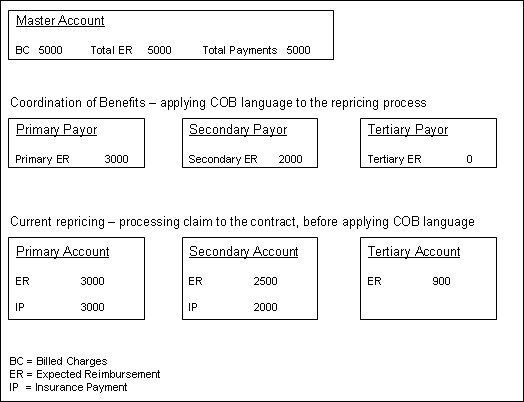COB Calculation Examples
The following diagrams illustrate COB calculations based on language types defined in the contract profile. The language types used for secondary and tertiary expected reimbursement calculations are determined by the language in each contract.
This scenario applies COB Language Type A according to the language in the contract. Language Type A calculates the difference between billed charges and the primary actual payment, not to exceed billed charges.
- For the secondary payor: 5000 – 3000 = 2000 (billed charges - primary actual payment). Since the 2000 does not exceed the billed charges, the payor-level secondary expected amount is 2000.
- For the tertiary payor: 5000 – 5000 = 0 (billed charges - all other actual payments). Since tertiary expected reimbursement would exceed billed charges, the payor-level tertiary expected amount is 0.
Note: If the primary payment is not present, the system uses the primary expected reimbursement. Once the primary payment information is received, the calculations are updated accordingly.
This scenario applies COB Language Type B according to the language in the contract. Language Type B calculates the difference between the secondary total expected payment and the primary actual payment, not to exceed billed charges.
- For the secondary payor: 1200 – 900 = 300 (secondary total expected payment - primary actual payment). Since the 300 does not exceed the secondary account’s expected reimbursement, the secondary payor expected amount is 300.
- For the tertiary payor: 900 – 1000 = -100 (tertiary total expected payment - all other actual payments). Since the expected reimbursement cannot be less than 0, the tertiary payor expected amount is 0.

